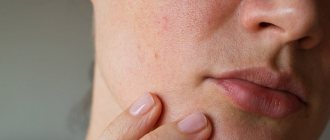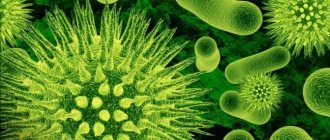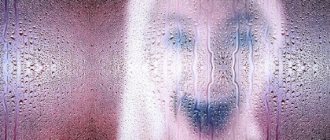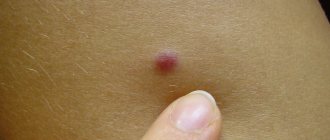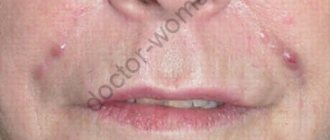Hives
According to statistics, almost every fifth of us at least once in our lives suffers from “itchy” diseases such as urticaria, angioedema or Quincke's edema. These tormentors can harass a person separately or together (in half the cases). Although it is sometimes difficult to determine the cause of rashes and blisters on the body, they are most often caused by allergens.
A doctor of the highest category, a specialist in allergic diseases, Doctor of Medical Sciences, Professor of the St. Petersburg Medical University named after Academician I.P., talks about prevention and ways to get rid of these unpleasant ailments. Pavlova Vyacheslav Anatolyevich Ignatiev.
Symptoms of urticaria
Urticaria, Quincke's edema and angioedema belong to a single group of allergic diseases with similar manifestations, but different development mechanisms.
The disease got its name - urticaria - for the characteristic pink blisters on the body, as if after a nettle burn, that turn pale under pressure, ranging in size from a millimeter to several centimeters, which cause unbearable itching. At the same time, the person’s temperature rises, weakness and headache occur. In susceptible people, urticaria affects areas of the skin or the entire body. According to the course of the disease, acute and chronic forms are distinguished.
In acute urticaria, a skin rash appears immediately after exposure to allergens or other irritants. Outbreaks of the rash usually subside after a few hours, less often they last for 24 hours. The disease itself goes away in 6-10 days. In the chronic form, the rash lasts for several months.
One of the most common types of the disease is cholinergic urticaria. It appears as a pinpoint, intensely itchy rash and blisters on the chest and neck. It is usually triggered by hot showers, exercise and emotional experiences. In patients with cold urticaria (exposure to cold water), blisters on the body usually appear not at the time of exposure to cold jets, but later. With urticaria pigmentosa, reddish-brown spots appear on the patient's skin. When scratched, they turn into blisters.
Angioedema (otherwise known as Quincke's edema, or giant urticaria) differs from ordinary urticaria in the depth of skin damage. Edema of significant size most often grows in places with loose tissue - on the lips, eyelids, cheeks, larynx, oral mucosa, external genitalia, and is accompanied by pain and burning in the affected areas.
In mild cases, Quincke's edema disappears without a trace after a few hours (sometimes after 2-3 days). Patients with moderate and severe forms should be hospitalized. The disease is especially dangerous due to swelling of the neck, mouth and larynx, as this can lead to suffocation. Hereditary angioedema is insidious, which can affect the gastrointestinal tract. It causes stomach cramps, nausea, vomiting, pain in the intestines, and the possible development of edematous laryngitis (inflammation of the larynx and vocal cords).
Angioedema manifests itself in allergic swelling of the lips, eyes, tongue, sometimes so severe that urgent medical attention is needed.
People with hypersensitivity to allergens should be extremely careful when choosing foods and taking medications to avoid these diseases. It is not recommended to consume peanuts, seafood, soy, fish, milk, wheat, chicken, tree nuts, food additives including sodium benzoate and sulfites, food colorings, and some fruits and berries (such as bananas and strawberries).
Medicines that can cause illness may include antibiotics (such as penicillin), sulfa and anti-inflammatory drugs, insulin, tranquilizers, codeine, painkillers, narcotics, some vaccines and serums. Aspirin rarely causes urticaria, but in the chronic form of the disease, the rash increases when taking aspirin.
Urticaria can be caused by the introduction of blood products or radiocontrast substances into the body; Quincke's edema and angioedema - drugs for heart failure and hypertension (Capoten, Renitek, Enap, Prestarium, etc.). The only reliable way to evaluate a drug as an allergen is to briefly stop taking it.
You should beware of the bites of bees, wasps, bumblebees, ants, as well as viral and parasitic infections (giardiasis, hepatitis, worms). Recurrences of urticaria are not uncommon in patients with chronic gastritis and peptic ulcers. It can also be “triggered” by fever, alcohol consumption, emotional factors, menstruation and other reasons.
Tips for hives
Itching, rash, swelling of the skin and mucous organs, blisters and blisters - all this is the result of the release of hytamine (this substance is present in all tissues of the body) under the influence of allergens. That is why, in the treatment of mild forms of diseases, antihistamines (Claritin, Zyrtec, Semprex, Telfast, Erius, etc.) are primarily prescribed. A combination of antihistamines and antidepressants may be used. Cleansing enemas and the use of enterosorbents (for example, activated carbon) often have a positive effect.
If the disease is severe, oral corticosteroids are taken in the clinic. Exacerbations of chronic urticaria will require treatment in specialized centers.
Treatment of urticaria with herbs
People susceptible to these “itchy” diseases should follow simple recommendations:
- bathe and wash your hands in warm water - avoid hot showers and baths, ice water, contact with ice (do not pick up ice cubes, for example); - do without harsh types of soap; — after bathing, apply moisturizers to the skin and dry with a soft towel; - Wear loose, lightweight cotton clothing; - try not to be in hot rooms; - Do not take aspirin, even if the outbreak has subsided; - if the body is overly excitable, use sedatives.
To prevent urticaria and the accompanying Quincke's edema and angioedema, ancient doctors recommend from time to time eating exclusively plant foods or at least for a while avoiding fatty meat, pork, game, spicy snacks and wine. Therapeutic folk advice is also effective. I can recommend some of them.
Wood lye. Burn the wood, pour clean ash with water, boil, let it settle, carefully drain the infusion, strain. Wash yourself with this lye. Boil 50 g of raspberry root over low heat for 15-20 minutes, leave for 1 hour, strain. Take 1/2 cup 4-6 times a day. Grate the celery root (you can put it through a meat grinder) and squeeze. Drink 1-2 teaspoons 2-3 times a day half an hour before meals. Or 2 tbsp. Infuse tablespoons of chopped fresh roots in 1 glass of cold water for 2 hours, strain. Drink 1/3 glass 3 times a day before meals. 1 tbsp. pour a spoonful of yarrow herb with 1 cup of boiling water (daily requirement), leave for 45 minutes. Drink 1/3 glass 3 times a day before meals. Or 1 tbsp. Pour 1 cup of boiling water over a spoonful of herbs and boil for 10 minutes. Drink 1/3 glass 2-3 times a day before meals. Or pour dry grass with 70% alcohol in a ratio of 1:10 and leave for 7 days. Take 40-50 drops 3 times a day. I would like to note that infusions, decoctions and tinctures of yarrow have high anti-allergic and blood purifying properties and normalize metabolism. Take dried duckweed in powder form, 1 tbsp. spoon 4 times a day before meals, with jam or honey (daily value - 16 g). When fresh, raw duckweed can be eaten as a salad, lightly salted and sprinkled with vegetable oil (daily value - 30 g). Or 1 tbsp. Pour 100 ml of boiling water over a spoonful of crushed duckweed, leave for 10 minutes and drink immediately. Take 4 times a day. Take 30 g of dead nettle leaves (white nettle) in 0.5 liters of water, bring to a boil, then cook over low heat for 2-3 minutes, leave for 1 hour, strain. Use for lotions. Pour 10 g of calendula officinalis inflorescences into 1/2 cup of boiling water and steam for 1-2 hours. Take 1 tbsp. spoon 2-3 times a day. Tincture of hawthorn and valerian: take both tinctures in equal quantities, mix and drop 30 drops into a glass of water. Take before bedtime. Small-leaved linden flowers - 25 g, fragrant woodruff grass - 20 g, walnut leaves - 50 g. Pour 2 teaspoons of this collection into 1 glass of boiling water, leave until completely cooled, strain. Drink 1 glass 2 times a day.
For complete recovery, it is useful to drink a fresh decoction of the series instead of tea and coffee for a long time. Brew the drink like tea and drink 20 minutes after brewing without limitation. The color of the decoction should be golden; if it is cloudy or green, it means that the string has lost its medicinal properties.
Acute urticaria - symptoms, treatment
Acute urticaria, which can last from several hours to several days, most often has an allergic nature. In contrast, chronic urticaria, which lasts for weeks or months, is very rarely an allergic reaction. Urticaria is often caused by food allergens and additives, as well as medications (often in the form of pseudo-allergies).
Symptoms
Hives can take many forms, but they are always characterized by a rash of blisters that may merge with each other. The rash can appear on any part of the body and is accompanied by severe itching.
Special forms of urticaria
Quincke's edema. The process affects the face and is accompanied by swelling of the lips, eyelids (“slit-like eyes”), mucous membranes and other parts of the body. There is no itching, but a painful burning sensation is felt.
Quincke's edema becomes life-threatening if the process spreads to the mucous membranes of the mouth and pharynx. A swollen tongue and back of the throat block the airway and can lead to suffocation.
The reasons for the development of urticaria are:
food allergens (eggs, fish, nuts, fruits); medications (penicillins, hormonal agents, sulfonamides); air allergens (pollen, wool, dust); insect bites (bees, wasps); infections (infectious mononucleosis, hepatitis B). Unlike allergic urticaria, there is one that is caused by physical factors: sun, cold, atmospheric pressure.
Hives - itchy blisters, how to treat
Urticaria is the general name for a group of diseases. The main symptom is itchy blisters, clearly demarcated, rising above the surface of the reddened skin, ranging in size from a few millimeters to several centimeters.
Acute urticaria is most often caused by medications, foods, infection, or hymenoptera bites. Chronic urticaria is often associated with a variety of pathologies. Cases of physical urticaria caused by cold, heat, physical activity, pressure, vibration, and sunlight are considered separately.
A feature of urticaria is its rapid development and equally rapid disappearance (from several minutes to several hours) after the administration of adequate therapy.
In clinical practice, the most commonly used classification of urticaria is based on etiological factors, for example, medicinal, food, mechanical (artificial), cold (the reaction to cold can be delayed, appearing after 1-2 days), thermal (occurs mainly before menstruation, during pregnancy, in the elderly, more often during the transition from cold to heat), toxic (with direct exposure to the skin of irritants - nettles, caterpillar hairs, jellyfish, bees, etc.), light (caused by ultraviolet, infrared and visible rays ).
Chronic forms of urticaria are often associated with dysfunction of the liver, kidneys, gastrointestinal tract, helminthic infestations, foci of chronic infection (in the tonsils, dental granulomas, gall bladder and duct, etc.), toxicosis of pregnant women, and decay products of malignant tumors.
Treatment of urticaria
Determining the cause of urticaria Removing the cause, if any, is the key to the success of further treatment. In the case of acute allergic urticaria, elimination diets are indicated that exclude the causative factor, as well as eliminating the allergen that has already entered the body using cleansing enemas (at least 3 days in a row). An elimination diet involves eliminating foods that can cause allergies or directly cause allergies. These include: chicken, strawberries (strawberries), citrus fruits (lemons, oranges, tangerines, grapefruit), chocolate and other sweets, smoked meats, spices, marinades, canned food, colored carbonated drinks, eggs. Treatment of urticaria involves taking antihistamines. The following antihistamines are used to treat urticaria: terfenadine, Bronal, teridine, Tofrin, astemizole, astelong, astemisan, gismanal, histolong, Zyrtec, Cetrin, Claritin, Lomilan, Kestin, Telfast. For cholinergic urticaria, the most effective are M-cholinergic blockers: bellataminal, bellaspon, belloid, etc.; Treatment of the underlying disease against which urticaria developed; correction of concomitant diseases.
To normalize the functional state of the digestive system, vitamins are prescribed: riboflavin, calcium pantothenate, vitamin U, ascorbic and nicotinic acids and pyridoxine in age-appropriate doses. To reduce vascular permeability and increase capillary tone, calcium chloride, glycerophosphate or gluconate is prescribed along with iron supplements, rutin or salicylates.
In particularly severe forms of urticaria, glucocorticoids are used briefly in combination with anabolic steroids (Nerobol, Retabolil).
External treatment is not significant. They use water-zinc pastes with 2-3% naftalan oil, as well as ointments and creams with glucocorticoid hormones (prednisolone, flucinar, fluorocort, lorinden C, deperzolon). At the same time, the same methods of physiotherapy are used as in patients with diffuse neurodermatitis.
How to treat urticaria and relieve severe itching due to urticaria
Hives. Allergic skin reaction. It is characterized by the appearance of blisters on the skin and mucous membranes - cavityless rashes, reminiscent of rashes that occur at the site of an insect bite or nettle burn. The rash can be pale red or bright red in color and vary in size. Most often it occurs on the skin of the torso, limbs, and often on the face, palms, and soles. The disease is always accompanied by severe itching, which intensifies under the influence of heat.
Hives begin suddenly, and just as quickly the rashes can disappear, leaving no traces behind. Hives may be accompanied by fever, dizziness, nausea, vomiting and even diarrhea.
Hives can be triggered by cold water, heat, various plants, flea, mosquito, tick bites, or the touch of jellyfish. Hives often occur after taking medications. Various foods can also cause food urticaria, the most dangerous are strawberries, strawberries, sausage, milk, sea fish, pork, eggs, etc. Sometimes urticaria appears against the background of diseases of the liver, pancreas, stomach, intestines, and helminthic infestation. Infectious diseases, acute and chronic, can also cause urticaria.
Giant urticaria, or Quincke's edema. Suddenly, swelling the size of a chicken egg appears in places with loose tissue - on the lips, eyelids, cheeks, oral mucosa or scrotum. It may go away without a trace in a few hours or 2-3 days. Quincke's edema of the larynx is especially dangerous: a hoarse voice, barking cough, shortness of breath, a bluish complexion, then suddenly turns pale. Without medical help, the patient may die from suffocation.
Treatment. First of all, it is necessary to find and eliminate the cause of the hives. In acute cases, you need to take a saline laxative (magnesia, 1 tablespoon dissolved in 1/4 glass of water, washed down with 1-2 glasses of water), and do a cleansing enema. After a saline laxative, the effect occurs within 4-6 hours. Take rhubarb 1 tablet 2 times a day before meals. The laxative effect after taking rhubarb occurs after 8-10 hours. You can brew laxative tea: mix 3 parts buckthorn bark, 2 parts nettle leaves, 1 part yarrow herb; Brew 1 tablespoon of the mixture with a glass of water, leave for 20 minutes, strain and drink 1/2-1 glass at night. It is recommended to take orally a 10% solution of calcium chloride, 1 tablespoon 3 times a day after meals, antihistamines (Zyrtec, Claritin, 1 tablet per day), rubbing the skin with antipruritic alcohol solutions of menthol, diphenhydramine, salicylic acid, and externally glucocorticoids. In case of Quincke's edema, you must immediately call a doctor; before his arrival, hot foot baths and diuretics (furosemide, etc.), and inhalations are recommended. An injection of 1 ml of a 0.1% solution of andrenamine is required, followed by antihistamines and corticosteroids. Further treatment as prescribed by the doctor.
I have hives. What to do?
9
What if the hives don't go away?
For chronic urticaria (those that last more than six weeks), in addition to detailed questioning, research will be required. Which ones depend on the results of the conversation with the doctor. Chronic spontaneous urticaria requires certain blood tests. Also, if there is some suspicion, the doctor can check for various infections or, in the case of a severe and long-term illness, for its autoimmune form.
But basically, the cause of chronic spontaneous urticaria in adults cannot be established. “In the absence of any other complaints and normal values of the general blood count, CRP [C-reactive protein] and/or ESR [erythrocyte sedimentation rate], other examinations do not need to be carried out and you just need to wait for spontaneous remission with properly selected symptomatic therapy,” writes Pavel Kolhir. “In Russia, the situation is the opposite: such patients often undergo extensive diagnostics to find the cause of CSU [chronic spontaneous urticaria], which is accompanied by a waste of time, money and nerves of the patient, and in the vast majority of cases such tests are not informative and are not necessary.”
Much less frequently and for certain signs, a skin biopsy may be required, that is, the doctor will take a small piece of skin from the blister for examination. This is necessary to exclude some similar diseases, in particular urticarial vasculitis.
If chronic induced urticaria is suspected, the doctor will try to provoke a reaction, for example, by applying an ice cube in the case of cold urticaria (this is called a provocative test).
Chronic induced urticaria can be provoked by:
- cold;
- warm;
- pressure;
- vibration;
- exercise stress;
- changes in body temperature (even due to strong emotions);
- sweat;
- sunlight (in very rare cases);
- stroking, scratching;
- contact with some product or, for example, metal (the reaction can only occur at the point of contact, which distinguishes this type of reaction from an allergy);
- skin contact with water (in very rare cases).
According to foreign recommendations, such patients can often be treated by a general practitioner (pediatrician or general practitioner). They may be referred to a specialist (allergist or dermatologist) if a provocative test is needed.
The first few lines of therapy can also be prescribed by a pediatrician or therapist, not a specialist. In cases where there is a suspicion of a specific disease that has caused urticaria, or it is obvious that antihistamines and glucocorticoids do not help and more complex treatment needs to be prescribed, it is recommended that the person be referred to a specialist: a dermatologist, an allergist-immunologist, a rheumatologist, etc.
In Russia, it is believed that any patient with chronic urticaria should see an allergist-immunologist or dermatologist (and children in general should be seen by such a specialist).
What tests are done for urticaria?
It is recommended to perform a general blood test with leukocyte formula, a biochemical blood test (C-reactive protein, liver and kidney parameters), a blood test for viral hepatitis, a blood test for general immunoglobulin E and specific immunoglobulins E for various allergens. In some cases, tests are necessary to exclude infections and parasitic infestations. A skin biopsy may be needed to examine it under a microscope. It is also possible to prescribe stress tests: exercise tolerance, applying an ice cube, heating pad, water compress to the skin, test for tolerance of pressure on the skin, ultraviolet radiation, vibration¹.
Important!
To correctly interpret test results, you must stop taking antihistamines 48 hours before the test.
Treatment methods
Hives go away on their own or after a single dose of antiallergic medications. Otherwise, long-term treatment with drugs in the required dosage is required. Having found out the root cause, they can treat in the following ways:
- Histaglobulin. Used for chronic, hereditary forms. Helps prevent laryngeal swelling in severe cases.
- Local cupping. Rashes on the face and hands are treated with ointments, folk remedies, and compresses.
- Systemic therapy. Antihistamines and decongestants are prescribed in different dosages.
- Etiotropic therapy. They eliminate any allergens, remove dust from surfaces, and regulate eating habits.
- Dexamethasone. Used to relieve the generalized form, can be replaced with Prednisolone.
First, second and third generation products are used. Due to the characteristics of the manifestations, the drug is often selected experimentally. Urticaria can be cured only after determining the cause of the disease. When angioedema develops, first aid is provided, allergy sufferers are given an intramuscular drug, and an ambulance is called.
Causes of urticaria
Because hives are a group of symptoms and not a single disease, they can occur for many different reasons⁴.
Factors from the external environment include:
- Allergens. Most often, urticaria is caused by allergic factors of a non-infectious nature: food allergens, house dust, animal hair, pollen, mold, insect bites, substances in contact with the skin. An allergic reaction to infectious agents also occurs: viruses, bacteria, fungi.
- Temperature. Hives can result from exposure to both cold and heat.
- Radiation. Excessive sun exposure can lead to solar urticaria.
- Pressure. Hives can be the result of pressure on the skin from clothing or a bag.
- Vibration. This reason is more common among people who work in conditions of high vibration.
- Water. In the case of aquagenic urticaria, which is very rare.
- Psychological factors. Stress, as well as active emotional reactions, can cause acute urticaria or lead to a relapse of chronic urticaria. This manifestation of the disease is also called nervous urticaria.
- Parasites. Helminths and protozoa.
- Chemical substances. Medicines, dietary supplements, and nutritional supplements cause hives in some people.
Figure 2. Causes of urticaria.
Image: MedPortal Factors from the body itself can also lead to urticaria:
- Hormonal disorders are diseases of the endocrine system.
- Exchange disorders. Diseases of the liver and kidneys in some cases lead to disruption of the neutralization and removal of chemical compounds from the body, which can manifest as skin symptoms.
- Autoimmune diseases: systemic lupus erythematosus, autoimmune thyroiditis, rheumatic diseases⁴.
In some cases, the cause of hives cannot be determined through diagnostic measures and tests. Then a diagnosis of “idiopathic urticaria” is made.
Important!
Hives are not contagious! Infection is impossible either from humans or animals.
Complications of urticaria
In addition to Quincke's edema, there is another threat - anaphylactic shock. This is a severe allergic reaction that can be fatal. There are several forms of anaphylaxis, and each of them has different symptoms (severe headache, abdominal complaints, and others).
If you have the slightest suspicion of an emergency, you should call a doctor as soon as possible. Treatment of mild forms of allergies does not cause difficulties: the patient is injected with adrenaline, a glucocorticosteroid, an IV is placed - and the critical situation passes.
If action is not taken quickly, the person may fall into a coma or even die.
What else can cause hives?
To avoid allergies more successfully, you need to think about every little thing that could cause reactions. For example, if you visit a restaurant and immediately or a few hours later your skin begins to itch, papules and blisters appear, then the first suspicions will fall on the food consumed in the establishment.
Allergens can be hidden in spices and seasonings, ready-made mixtures, complex cocktails, and store-bought semi-finished products. After the first episode of hypersensitivity, it is important for you to prevent new episodes, and also to always remember what and where you did, drank, ate, smelled, touched.
Symptoms of urticaria
Urticaria is manifested by itching and burning of the skin accompanied by the appearance of blisters.
The rash can be the size of a penny or in the form of merging separate large foci of irregular shape. If urticaria lasts more than 3 months, it is called chronic. With giant urticaria, the deep-lying parts of the skin and subcutaneous tissue undergo swelling. Angioedema of Quincke, occurring on the mucous membranes, can cause dysfunction of various organs and systems. With swelling of the larynx, difficulty breathing may occur, up to asphyxia; if localized on the mucous membranes of other organs, dysuric phenomena, symptoms of acute gastroenteritis, and intestinal obstruction may occur. Angioedema lasts from several hours to several days and disappears without a trace. In case of food allergies or helminthic infestations, the swelling can take a recurrent course. With contact urticaria, which occurs from contact with ragweed, primrose, poison ivy (phytodermatitis), glandular contents of caterpillars, cosmetics, and other haptens in production conditions, the rash can appear acutely, quickly, or many hours later; when scratching, it spreads beyond the contact the named substances with the skin.
In childhood urticaria, the appearance of small blisters is noted against the background of exudative diathesis and hypersensitivity to a number of foods.
Urticaria during pregnancy
During pregnancy, a woman often develops hives due to hormonal changes. The rashes are not contagious and are accompanied by insomnia, increased irritability, weakness, and aching joints. Provoke the appearance of urticaria:
- lack of rest, sleep;
- weakened immune system;
- hormonal disbalance;
- severe stress;
- change of eating habits.
Pregnant women have a higher risk of developing a one-time case into a chronic form than others. Therefore, at the first signs, you cannot use the drugs yourself; you need to visit a doctor. After examination and tests, a medical specialist may prescribe:
- injections;
- taking sorbents;
- restoratives;
- immunomodulators;
- probiotics;
- folk remedies.
The treatment itself takes place at home, no hospital is required. During this period, it is difficult to select antihistamines that would be safe for the fetus. In rare cases, hormonal ointments and steroids are prescribed. To relieve swelling and itching, emollient non-hormonal ointments are selected.
Diagnosis of urticaria
Urticaria is diagnosed during an examination by an allergist-immunologist and does not require special methods for confirmation. In the acute form of the disease, the cause is usually determined after the patient’s condition has stabilized. When examining a doctor, the following questions are primarily of interest:
- Time of onset of symptoms and duration of urticaria.
- Frequency of disease episodes.
- The nature of the rash. The patient describes the size, shape, color, localization of the rash elements, and the intensity of itching. This stage of the survey is facilitated by photographs of rashes at different stages of their development (when they appear, after an hour, a day, etc.).
- Presence or absence of angioedema.
- Changes in skin appearance during the day.
- Relationship between symptoms and weekends, holidays, menstrual cycle, stress, and meals.
- Chronic diseases of the patient, allergic reactions to anything, previous infections.
- Allergies and atopic diseases in the family.
- Treatments previously used and their effectiveness.
- Results of previous laboratory studies.
- Professional activities and hobbies of the patient³.
Sources
- Federal clinical guidelines for the diagnosis and treatment of urticaria. M.: Russian Association of Allergists and Clinical Immunologists, 2015. p. 34.
- Federal clinical guidelines for the management of patients with urticaria. M.: Russian Society of Dermatovenerologists and Cosmetologists, 2015. p. 24.
- Guideline for the definition, classification, diagnosis and management of urticaria: the 2013 revision and update / Zuberbier T., Aberer W., Asero R. // Allergy 2014: 69: 868-887.
- Luss. L.V. Causes and treatment of urticaria in children // Medical Council, 2015. – No. 14.
